Subscribe to our ▶️ YouTube channel 🔴 for the latest videos, updates, and tips.
Subtraction of Whole Numbers
Subtraction of numbers with more than five digits can be done in the same way as we have learnt to do subtraction of smaller number earlier. We arrange the numbers one below the other in place-value columns. We start subtracting them one by one from the right most column and borrow if required, from the column on left.
Subtraction of whole numbers is discussed in the following two steps to subtract one large number from another large number:
Step I:
We arrange the given numbers in columns, ones under ones, tens under tens, hundred under hundreds and so on.
Step II:
Beginning with the ones, we go on subtracting column wise, borrowing if necessary, from the next column to the left.
We borrow from millions column to hundred thousands column from hundred thousands column to ten thousands column from ten thousands column to thousands column from thousands column to hundreds column from hundreds column to tens column and from tens column to ones column.
For Example:
1. Subtract 2478652 from 8364579.
Solution:
We arrange the given numbers in columns (minuend on the top and subtrahend under it) and subtract as under:
8364579
- 2478652
We need to subtract the ones column and the tens column as usual because here we don’t need to borrow numbers as the bottom numbers are smaller than the numbers on the top.
Now we borrow 1 million from 8 millions. Then we get (8 - 1) = 7 millions in the millions column.
Now in place of 3 hundred thousands we have 13 hundred thousands in the hundred thousands column. Now borrow 1 hundred thousand from 13 hundred thousands. Then we get (13 - 1) = 12 hundred thousands in the hundred thousands column.
Then in place of 6 ten thousands we have 16 ten thousands in the ten thousands column. Now borrow 1 ten thousand from 16 ten thousands. Then we get (16 - 1) = 15 ten thousands in the ten thousands column.
Again, in place of 4 thousands we have 14 thousands in the thousands column. Now borrow 1 thousand from 14 thousands. Then we get (14 - 1) = 13 thousands in the thousands column.
5 hundreds + 1 thousand borrowed become 15 hundreds in the hundreds column.
Therefore, now we just need to subtract after borrowing the numbers since we observe that the bottom numbers are smaller than the numbers on the top.
2. Subtract 1076799 from 1205620.
Solution:
We arrange the given numbers in columns (minuend on the top and subtrahend under it) and subtract as under:
1205620
- 1076799
In this subtraction problem we observe that upto ten thousands column all the bottom numbers are bigger than the numbers on the top.
So, we will start borrowing numbers from hundred thousands column.
Now we borrow 1 hundred thousand from 2 hundred thousands. Then we get (2 - 1) = 1 hundred thousand in the hundred thousands column.
Now in place of 0 ten thousand we have 10 ten thousands in the ten thousands column. Now borrow 1 ten thousand from 10 ten thousands. Then we get (10 - 1) = 9 ten thousands in the ten thousands column.
Then in place of 5 thousands we have 15 thousands in the thousands column. Now borrow 1 thousand from 15 thousands. Then we get (15 - 1) = 14 thousands in the thousands column.
Again, in place of 6 hundreds we have 16 hundreds in the hundreds column. Now borrow 1 hundred from 16 hundreds. Then we get (16 - 1) = 15 hundreds in the hundreds column.
Now in place of 2 tens we have 12 tens in the tens column. Now borrow one ten from 12 tens. Then we get (12 - 1) = 11 tens in the tens column.
0 ones + 1 ten borrowed become 10 ones in the ones column.
Therefore, now we just need to subtract after borrowing the numbers since we observe that the bottom numbers are smaller than the numbers on the top.
3. Subtract 3214658 from 5645789
Solution:
Hence, 5645789 – 3214658 = 2431131.
4. Subtract 65248907 from 86165281
Solution:
Hence, 86165281 – 65248907 = 20916374
Subtraction of larger numbers are also done as usual. Let us consider some examples
5. Subtract 2,38,40,090 from 9,24,58,306.
Solution:
The given numbers are in the Indian system, so we place comma (,) in the sum according to the Indian system.
9 2 4 5 8 3 0 6
- 2 3 8 4 0 0 9 0
6 8 6 1 8 2 1 6
Therefore, the answer is 6,86,18,216.
6. Subtract 142,098,386 from 321,836,589.
Solution:
The given numbers are in the International system, so we place comma (,) in the sum according to the International system.
3 2 1 8 3 6 5 8 9
- 1 4 2 0 9 8 3 8 6
1 7 9 7 3 8 2 0 3
Therefore, the answer is 179,738,203
Word Problems on Subtraction of Whole Numbers:
1. A factory produced 313650000 candies in the month of December for Christmas. Out of these 105224010 were of lavender flavor. How many of the candies were not of lavender flavor?
Solution:
Number of candies produced = 313650000
Number of candies of lavender flavor = 105224010
Number of candies not having lavender flavor
Hence, the total number of candies not having lavender flavor = 208425990.
2. The population of a state is 97652054. Before fifteen years, it was 64782943, Find the increase in the population.
Solution:
Total population of a state = 97652054
Population before fifteen years = 64782943
Total increase in the population of the state during fifteen years
= 97652054 - 64782943
= 32869111
Thus, the total increase in the state population during fifteen years is 32869111.
3. The population of a country in the year 2002 was 15,69,21,435. If there were 6,47,87,038 men and 6,32,37,683 women in the country. What was the number of children in the country in that year?
Solution:
Total number of men = 6,47,87,038
Total number of women = + 6,32,37,683
12,80,24,721
Total population of country = 15,69,21,435
Total number of men and women = - 12,80,24,721
Total number of children = 2,88,96,714
Solve the given Word Problems on Subtraction of Whole Numbers:
1. A country has a population of 651399888. If 304628040 are females, then how many are males?
Answer: 346771848
2. 1432884 people visited the international book fair on Saturday and Sunday. The number of people visiting the fair on weekdays was 89745 less than that on weekend. How many people visited the fair on weekdays?
Answer: 1343139
3. Find the number that is:
(i) 30000 less than 183645800
(ii) 1200000 less than 483625900
Answer:
(i) 183615800
(ii) 482425900
Note: We can subtract 7-digit, 8-digit and 9-digit numbers in the same way as we subtract 5-digit and 6-digit numbers.
We know, the number which is to be subtracted is known as 'subtrahend' and the number from which it is subtracted is known 'minuend' and the answer we get is known as the 'difference' the number is placed below the number from which it is subtracted.
- Addition Of Whole Numbers.
- Word Problems on Addition and Subtraction of Whole Numbers
- Subtraction Of Whole Numbers.
- Multiplication Of Whole Numbers.
- Properties Of Multiplication.
- Division Of Whole Numbers.
- Properties Of Division.
- Word Problems on Multiplication and Division of Whole Numbers
- Worksheet on Addition and Subtraction of Large Numbers
- Worksheet on Multiplication and Division of Large Numbers
- Worksheet on Operations On Whole Numbers
From Subtraction of Whole Numbers to HOME PAGE
Didn't find what you were looking for? Or want to know more information about Math Only Math. Use this Google Search to find what you need.
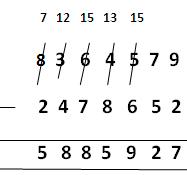
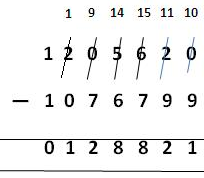
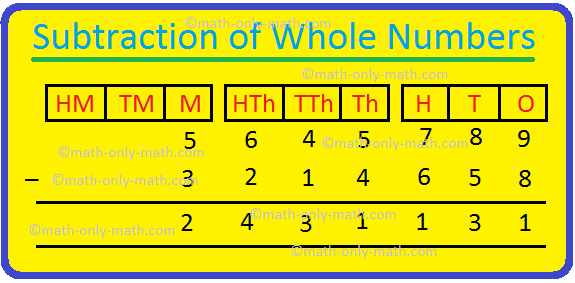
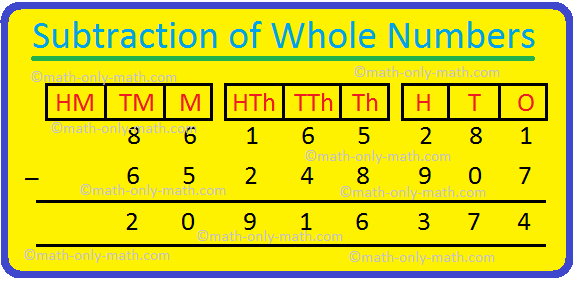
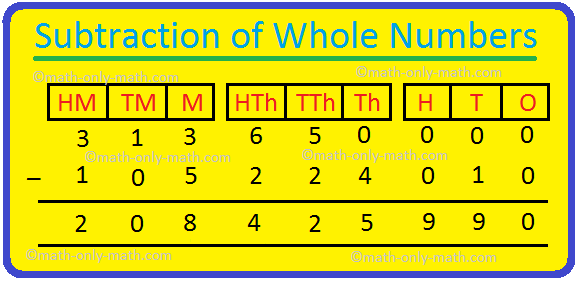


New! Comments
Have your say about what you just read! Leave me a comment in the box below. Ask a Question or Answer a Question.